Feynman Path Integrals in Quantum Mechanics
Feynman Path Integrals in Quantum Mechanics
Feynman Path Integrals in Quantum Mechanics
- No tags were found...
You also want an ePaper? Increase the reach of your titles
YUMPU automatically turns print PDFs into web optimized ePapers that Google loves.
over η. The result<strong>in</strong>g <strong>in</strong>tegrals are Gaussian and can be solved explicitely. Expand<strong>in</strong>g 8 tofirst order <strong>in</strong> ɛ and second order to η leeds then to the equationΨ + ɛ ∂Ψ∂t = Ψ − iɛ¯h V Ψ − ¯hɛ ∂ 2 Ψ2im ∂x 2 . (15)(15) is true <strong>in</strong> first order to ɛ, if Ψ satisfies [def<strong>in</strong><strong>in</strong>g H = − ¯h22m ∂x+ V ] the differential2Equation−¯h ∂Ψ= HΨ , (16)i ∂twhich is the Schröd<strong>in</strong>ger equation!3.2 Schröd<strong>in</strong>ger Equation for the KernelThe kernel K(2, 1) <strong>in</strong>troduced by (6) is only def<strong>in</strong>ed for t 2 > t 1 . S<strong>in</strong>ce K(2, 1), consideredas a function of the variables 2, is a special wave function it is clear that (16) is satisfied:−¯hi∂Ψ∂t 2K(2, 1) − H 2 K(2, 1) = 0 for t 2 > t 1 (17)Where H 2 acts on the variables 2 only.If we def<strong>in</strong>e K(2, 1) = 0 for t 2 < t 1 , (17) is also valid for t 2 < t 1 but K(2, 1) getsdiscont<strong>in</strong>ous at t 2 = t 1 . One can show, that the kernel satisfies−¯hi∂Ψ∂t 2K(2, 1) − H 2 K(2, 1) = −¯h i δ(x 2 − x 1 )δ(t 2 − t 1 ) (18)Remark:We <strong>in</strong>troduced K(2, 1) as the probability amplitude. Another possibility is to start fromthe usual formulation of <strong>Quantum</strong> <strong>Mechanics</strong>. The kernel can then be def<strong>in</strong>ed as theGreen’s function for the Schröd<strong>in</strong>ger equation. This means: one def<strong>in</strong>es K(2, 1) to bethe solution of Eq. (18). This is equivalent 9 to the follow<strong>in</strong>g def<strong>in</strong>ition <strong>in</strong> the betterknown Dirac representation: K(2, 1) = 〈x 2 |Û(t)|x 1〉, where Û(t) = e−iĤt/¯h as long as theHamiltonian is time-<strong>in</strong>dependent.F<strong>in</strong>ally we remark that K(2, 1) only depends on the time difference (t 2 − t 1 ) [as longas the Hamiltonian is time-<strong>in</strong>dependent].4 Pertubation TheoryThe idea of Pertubation theory <strong>in</strong> the path <strong>in</strong>tegral formulation of <strong>Quantum</strong> <strong>Mechanics</strong>is quite simple. We look at a particle mov<strong>in</strong>g <strong>in</strong> some potential 10 V (x, t). If we <strong>in</strong>sert (4)<strong>in</strong> (6) and expand the exponential, we getK V (2, 1) = K 0 (2, 1) + K 1 (2, 1) + K 2 (2, 1) + · · · , where (19)∫ 2[ ( ∫ īt2mẋ 2 )]K 0 (2, 1) = exp1 h t 12 dt Dx(t) (20)K 1 (2, 1) = − ī ∫ 2[ ( ∫ īt2mẋ 2 )] ∫ t2exph 1 h t 12 dt V [x(s), s]ds Dx(t) (21)t 1K 2 (2, 1) = − 1 ∫ 2[ ( ∫ īt2mẋ 2 )] [∫ t2] 22¯h 2 exp1 h t 12 dt V [x(s), s]ds Dx(t) (22).8 Demand<strong>in</strong>g this expansion to be true <strong>in</strong> the limit ɛ → 0, the promised condition <strong>in</strong> A appears, with the result A = 2πi¯hɛ 1/2.9mThis follows from ”normal” <strong>Quantum</strong> <strong>Mechanics</strong>. Discussed <strong>in</strong> [4], [5]10 The <strong>in</strong>dex V <strong>in</strong> Eq. (19) shall just symbolize that the particle is mov<strong>in</strong>g <strong>in</strong> some potential V (x, t)t 1∂ 25



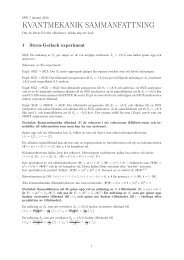

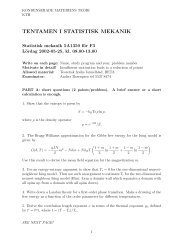
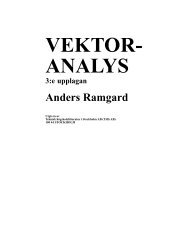
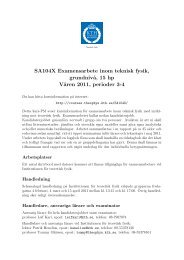

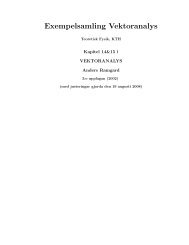

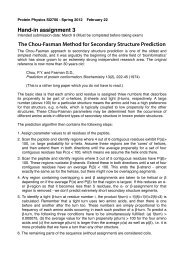

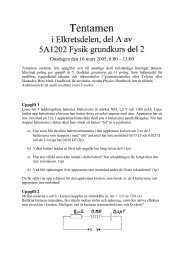
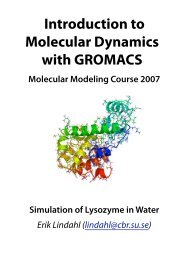
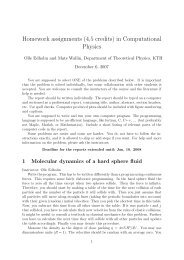
![[VAR]=Notes on variational calculus](https://img.yumpu.com/35639168/1/190x245/varnotes-on-variational-calculus.jpg?quality=85)